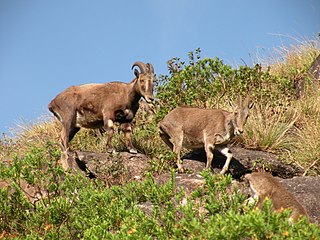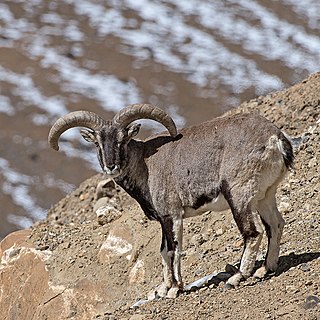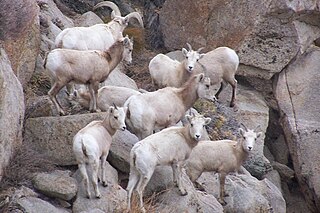
The northern shrike is a large songbird species in the shrike family (Laniidae) native to North America and Siberia. Long considered a subspecies of the great grey shrike, it was classified as a distinct species in 2017. Six subspecies are recognised.

The mouflon is a wild sheep native to Cyprus, and the Caspian region, including eastern Turkey, Armenia, Azerbaijan, Georgia and Iran. It is also found in parts of Europe. It is thought to be the ancestor of all modern domestic sheep breeds.

The bighorn sheep is a species of sheep native to North America. It is named for its large horns. A pair of horns may weigh up to 14 kg (30 lb); the sheep typically weigh up to 143 kg (315 lb). Recent genetic testing indicates three distinct subspecies of Ovis canadensis, one of which is endangered: O. c. sierrae.

Ovis dalli, also known as the Dall sheep or thinhorn sheep, is a species of wild sheep native to northwestern North America. Ovis dalli contains two subspecies: Ovis dalli dalli and Ovis dalli stonei. O. dalli live in mountainous alpine habitats distributed across northwestern British Columbia, the Yukon, Northwest Territories and Alaska. They browse a variety of plants, such as grasses, sedges and even shrubs, such as willow, during different times of the year. They also acquire minerals to supplement their diet from mineral licks. Like other Ovis species, the rams engage in dominance contests with their horns.

The Nilgiri tahr is an ungulate that is endemic to the Nilgiri Hills and the southern portion of the Western and Eastern Ghats in the states of Tamil Nadu and Kerala in southern India. It is the only species in the genus Nilgiritragus and is closely related to the sheep of the genus Ovis.

Capra is a genus of mammals, the goats, comprising ten species, including the markhor and several species known as ibexes. The domestic goat is a domesticated species derived from the bezoar ibex. It is one of the oldest domesticated species of animal—according to archaeological evidence its earliest domestication occurred in Iran at 10,000 calibrated calendar years ago.

The bharal, also called the blue sheep, is a caprine native to the high Himalayas. It is the only member of the genus Pseudois. It occurs in Pakistan, India, Nepal, Bhutan, Myanmar, and in China in the provinces of Gansu, Ningxia, Sichuan, Tibet, and Inner Mongolia. The Helan Mountains of Ningxia have the highest concentration of bharal in the world, with 15 bharals per km2 and 30,000 in total.

The Sierra Nevada bighorn sheep is subspecies of bighorn sheep unique to the Sierra Nevada mountains of California. A 2016 genetics study confirmed significant divergence between the three subspecies of North America's bighorn sheep: Sierra Nevada bighorn sheep, Rocky Mountain bighorn sheep and desert bighorn sheep. Sierra Nevada bighorn sheep were listed as a federally endangered subspecies in 2000. In 2016, over 600 Sierra bighorn remained in the wild. However, in 2023, more recent studies indicate that the population has dropped to approximately half, or 300. This is due to high levels of mountain lion predation combined with heavy snowfall, threatening the species even further.

The argali, also known as the mountain sheep, is a wild sheep native to the highlands of western East Asia, the Himalayas, Tibet, and the Altai Mountains.

The Pantherinae is a subfamily of the Felidae; it was named and first described by Reginald Innes Pocock in 1917 as only including the Panthera species, but later also came to include the clouded leopards. The Pantherinae genetically diverged from a common ancestor between 9.32 to 4.47 million years ago and 10.67 to 3.76 million years ago.

The Marco Polo sheep is a subspecies of argali sheep, named after Marco Polo. Their habitat are the mountainous regions of Central Asia. Marco Polo sheep are distinguishable mostly by their large size and spiraling horns. Their conservation status is "near threatened" and efforts have been made to protect their numbers and keep them from being hunted. It has also been suggested that crossing them with domestic sheep could have agricultural benefits.
The Neanderthal genome project is an effort, founded in July 2006, of a group of scientists to sequence the Neanderthal genome.

The Himalayan wolf is a canine of debated taxonomy. It is distinguished by its genetic markers, with mitochondrial DNA indicating that it is genetically basal to the Holarctic grey wolf, genetically the same wolf as the Tibetan and Mongolian wolf, and has an association with the African wolf. No striking morphological differences are seen between the wolves from the Himalayas and those from Tibet. The Himalayan wolf lineage can be found living in Ladakh in the Himalayas, the Tibetan Plateau, and the mountains of Central Asia predominantly above 4,000 m (13,000 ft) in elevation because it has adapted to a low-oxygen environment, compared with other wolves that are found only at lower elevations.

The Armenian mouflon is an endangered subspecies of mouflon endemic to Iran, Armenia, Nakhchivan Autonomous Republic of Azerbaijan, Turkey and Iraq.

The snow leopard is a species of large cat in the genus Panthera of the family Felidae. The species is native to the mountain ranges of Central and South Asia. It is listed as Vulnerable on the IUCN Red List because the global population is estimated to number fewer than 10,000 mature individuals and is expected to decline about 10% by 2040. It is mainly threatened by poaching and habitat destruction following infrastructural developments. It inhabits alpine and subalpine zones at elevations of 3,000–4,500 m (9,800–14,800 ft), ranging from eastern Afghanistan, the Himalayas and the Tibetan Plateau to southern Siberia, Mongolia and western China. In the northern part of its range, it also lives at lower elevations.

The Denisovans or Denisova hominins are an extinct species or subspecies of archaic human that ranged across Asia during the Lower and Middle Paleolithic, and lived, based on current evidence, from 285 thousand to 25 thousand years ago. Denisovans are known from few physical remains; consequently, most of what is known about them comes from DNA evidence. No formal species name has been established pending more complete fossil material.

Denisova Cave is a cave in the Bashelaksky Range of the Altai Mountains in Siberia, Russia.

Putoransky State Nature Reserve( Путоранский заповедник ) is a Russian 'zapovednik' in the northern part of Central Siberia in Russian Federation, located about 100 km north of the Arctic Circle in Krasnoyarsk Krai, includes the Putorana Plateau. It was established in 1987, and since 1987 has been designated as a World Heritage Site by UNESCO. It covers an area of 1,887,252 hectares of which 1,773,300 are monitored. Its headquarters are in Norilsk.

The wild Bactrian camel is an endangered species of camel endemic to Northwest China and southwestern Mongolia. It is closely related but not ancestral to the domestic Bactrian camel. Genetic studies have established it as a separate species which diverged from the Bactrian camel about 0.7–1.1 million years ago.




















